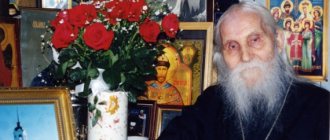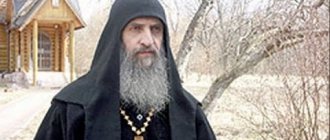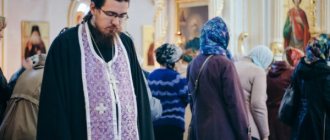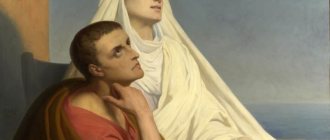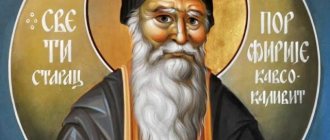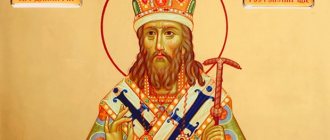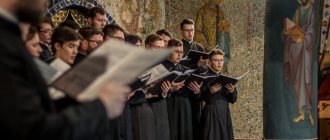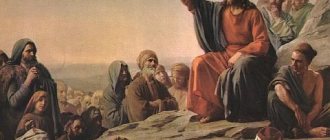Anna saw her father's pale face. Only before her tonsure did she realize how difficult it is for a man to let go of his beloved daughter. The joy in the girl's heart was mixed with a feeling of loss.
“Only for you, Lord,” she whispered. After the ceremony, the girl looked after the carriage taking away the priest. The carriage stopped and the man got out.
He looked at his daughter for a long time, then turned sharply and, without saying a word, rushed away. He let the girl go, because he knew that her calling was to be a nun...
Abbess Arsenia Sebriakova knew from her youth that her calling was to be with God
Love for God in Annette's little heart
The worldly name of the future abbess is Anna Sebryakov. Born in 1833
The girl's parents were deeply religious people. They tried to raise their children in the same spirit.
1833
year of birth of Anna Sebryakova, future abbess Arsenia
When Annette was 6 years old, her mother died. The father did not want to look for a new wife. The man found his consolation in children.
Mikhail Vasilyevich was a stern man with military training. He kept the guys strict.
He rarely played with them, but loved to gather in the living room and read passages of Scripture.
Long discussions touched the girl’s heart, but the teachings of Christ left an even greater mark.
The teachings of Christ greatly touched the heart of little Annette.
Annette began to study the Gospel on her own. Sometimes she hid it under the covers of other books so as not to attract too much attention to herself. The Savior's commandments and His instructions seemed wise and simple to the girl at the same time. And the thought that people do not follow the commandments and live in sin caused mental pain.
Not only did Annette study the Word of God. Her father graduated from the Faculty of Mathematics at Kharkov University and sought to educate his children.
Mikhail Vasilyevich hired teachers in various disciplines. So, the girl had the opportunity to learn the technique of icon painting.
“I love only the Lord; didn’t you yourself teach to love Him?”
In her youth, Annette’s faith became even stronger. The girl began to noticeably differ from her sisters. The desire for privacy and simple clothes surprised those around him.
One day, her father decided to bring Annette into the world. She humbly obeyed, but the girl did not like celebrations and parties.
Instead of getting married, Annette asked her father's permission to enter a monastery.
When Mikhail Vasilyevich looked for a worthy young man for his daughter, she replied that she loved only God and asked permission to go to a monastery.
It was not easy for a man to let go of his beloved child, knowing what trials awaited her within the walls of the monastery. For some time, the man hoped that this was a temporary impulse, that his daughter would change her mind.
He provided her with a separate carriage with horses, gave her the opportunity to attend services and be in solitude. But six months later, Annette repeated her request, and her father agreed.
Having visited Kyiv, Anna realized that her place was in her native monastery
Neither the nuns nor the abbess of the monastery herself, Abbess Bathsheba, were ready to enter into complex discussions, so they never became the girl’s spiritual mentors.
Then novice Anna began to ask permission to go on a pilgrimage to Kyiv. The abbess was afraid to let her go on such a long journey.
Anna made her first test trip to the Kremenskaya monastery, which was located more than 80 km from the monastery.
Holy Ascension Kremensky Monastery, where novice Annette made her first pilgrimage
In 1853, the novice was released to Kyiv. Together with her companions, she walked. Ordinary gray clothes, a scarf, a knapsack - nothing betrayed the pilgrim as a girl of a noble family. The houses of poor peasants were chosen for lodging for the night. Sometimes they slept on the floor.
Having reached Kyiv, Anna learned that a cholera epidemic had begun in the city. Despite the entreaties of her companions, the girl decided to continue her journey. She bravely communicated with the sick and tried to ease their suffering. Thanks to God's help, none of the pilgrims became infected.
Traveling through the holy places of Kyiv, Anna admired the beauty of the temples. But the spiritual manifestations of life were not close to her. Then she decided to return to the Ust-Medveditsky Monastery, work there, pray, strengthen her own faith and help others find God.
An appeal to Mother Arsenia with your photo attached to the miraculous stone
in the Ust-Medveditsky Spaso-Preobrazhensky Monastery, Serafimovich
You have a unique opportunity to virtually visit a powerful place of power (using your photo). Then you receive this photo back by mail with an icon of Mother Arsenia and an image of the miraculous stone. A service for your health will also be ordered for six months in the Ust-Medveditsky Spaso-Preobrazhensky Monastery, which is located above this stone.
The decision to canonize Abbess Arsenia was made in accordance with the earlier petition of the Bishops' Council of the Volgograd Metropolis received by the Holy Synod. This was good news not only for the novices of the monastery, but also for all Orthodox believers. November 13 was set as the date of glorification.
Considering the question of canonizing Abbess Arsenia, the Diocesan Commission examined cases of healing from illnesses that occurred after prayerful appeals to her. The most common evidence of healing of women from infertility
In the underground cell lies one of the main shrines of the monastery - according to legend, the Stone of Tears and Repentance with imprints of knees and palms that belonged to Abbess Arsenia. During her lifetime, no one knew about it, but the artifact was discovered in the 70s under a layer of garbage by local residents who began to clear the caves.
According to the testimony of the sisters of the monastery devastated under Soviet rule, the Mother of God herself appeared to Mother Arsenia during fervent prayer on this stone.
It is believed that if you touch the stone, you can be cured of diseases and various ailments. By the way, Soviet scientists in the 70s. last century, they studied the stone using ultrasound and could not understand what it consisted of. They concluded that the stone is of extraterrestrial origin, since there is no such rock on our planet, although its structure is similar to granite.
You have a unique opportunity to virtually visit a powerful place of power (using your photo). Then you receive this photo back by mail with an icon of Mother Arsenia and an image of the miraculous stone. A service for your health will also be ordered for six months in the Ust-Medveditsky Spaso-Preobrazhensky Monastery, which is located above this stone
submit an Appeal to Mother Arsenia with your photo attached to the miraculous stone here: https://elma.justclick.ru/order/arseniy/
If you liked the article, tell your friends
Taking tonsure, serving the Lord and people
In 1854 Anna took monastic vows.
Since then they began to call her Arsenia, in honor of Saint Arsenius the Great.
In 1859 she was tonsured into the robe.
1854
this year Anna took monastic vows and received the name Arsenia
At this time, Mother Arsenia found a spiritual mentor.
She became schema-nun Ardalion. Despite her strict vow and desire for solitude, the schema-nun found time every day for discussions with Arsenia.
One day she said:
“You offer such questions,
that it is impossible to answer them in one word,
and it’s not always convenient to talk in church.
If the abbess gives her blessing, then it’s better for you to come to my cell,
although I don’t accept anyone, I will accept you,
not because you are Arsenia, but because I see
you truly desire to be saved.”
In 1862 Bishop John appointed Mother Arsenia to the position of treasurer and chief assistant to the abbess.
In 1864, after the death of Bathsheba, Arseny was elected abbess of the Ust-Medveditsk monastery.
1864
this year Mother Arsenia was elected abbess of the Ust-Medveditsk monastery
Having received the position, the young abbess launched active efforts to improve the monastery and educate young people.
Arsenia became the youngest abbess in history
For her actions, Arsenia received awards:
- Cross with precious decorations from the cabinet of His Imperial Majesty.
- Bible from the Holy Synod.
- The pectoral cross, decorated with jewelry, was donated by sisters from the monastery in 1994.
- Red cross sign.
Venerable Arsenia Ust-Medveditskaya (Sebryakov)
Memorial Day: July 21 (August 3)
Daughter of the famous general Mikhail Vasilyevich Sebryakov. Anna was born on July 3, 1833 in Sebrovo, Ust-Medveditsky district, into a rich and famous family. The Sebryakov family is the oldest in the region.
Their ancestor Sebr was killed during the capture of Azov by the Cossacks, but whether this is true or a legend is not exactly known. Anna's father, Mikhail Vasilyevich, graduated from the Faculty of Mathematics of Kharkov University. He had the rank of headquarters captain and served as a military treasurer, assessor of the military chancellery, was an honorary caretaker of the Ust-Medveditsky district school and a military noble deputy.
As a young man, he commanded a Cossack regiment in the Prussian company. For his bravery in 1762, Empress Catherine II elevated him to army colonel. In 1767 he took part in the Turkish War. During the Pugachev riot he was appointed commander of the main Cossack militia, but due to complicated circumstances he fled. According to the decree of the Government, it was ordered to “bring Sebryakov to the strictest court... the death penalty: by hanging on the gallows.” But by decree of the empress he was forgiven.
Having become a widower, he moved with his children to the settlement of Sebrovo, founded by his ancestors, where he took up science. At the age of sixteen, her father wanted to marry Anna, but she expressed a desire to retire to a monastery. She was given freedom of choice, but her father tried to ensure that Anna was educated, for which he hired teachers and masters, in particular in icon painting, which was useful to her in the future. In 1850, the father gave his daughter to the Ust-Medveditsky Monastery. It was an honor for the monastery to receive the daughter of the famous commander M.V. Sebryakov.
The monastery of that time was a poor, deserted monastery with two churches and a number of tiny cells. Anna was dressed in monastic dress and assigned to obedience. In her free time, she read spiritual books, prayed at night, painted and painted a number of icons. Anna was settled in the cell of a distant relative of M. Sebryakov, nun Leonida (Ladygina). For her diligent obedience, Abbess Bathsheba transferred Anna to the abbot's house, which caused her to feel constrained in her spiritual life. The exploits of Ig. Bathsheba seemed aimless to her, which forced her to look for a spiritual leader on the side, but all to no avail.
In this mood, she undertook a trip to the holy places of Kyiv, but encountered obstacles from the abbess, who feared for her health. Only a year later she was allowed to visit the Kremen Monastery, located eighty miles from Ust-Medveditsky, to test her strength. A year later, in 1853, Anna was able to go on a pilgrimage to Kyiv. She was amazed by the grandeur of the temples and their church decoration, but the internal life of the monastery did not satisfy her. This journey dispelled her zealous mood, the search for something spiritual, as if Christ was “in the desert” or “in hidden rooms”, confirmation of which we find in the Gospel.
She returned to the monastery and in 1854 she was tonsured into the ryassophore (the lowest degree of tonsure, preparing for the adoption of the minor schema) with the name Arseny, in honor of Arseny the Great, and in 1859 on January 11, into the mantle, apparently with the name retained. Soon she found herself a mentor in the person of schema-nun Ardaliona. In 1862, due to his old age. Bathsheba Arsenia was appointed by Bishop John, who ruled the Don diocese, as an assistant to the abbess with the appointment to the post of treasurer. In 1863, Ig. died. Bathsheba. There was a need to choose a new abbess; the choice of sisters fell on Arsenia. 1864 became significant for Arsenia. On January 3, in the 31st year of her life, she was ordained to the rank of abbess by Archbishop John. The newly installed abbess had to change her secluded, quiet life to vigorous activity. Some time later, her spiritual mentor, schema, died. Ardalion. Empowered ig. Arsenia took up the arrangement of the monastery, both from the outside and from the inside. Her first task was to spread literacy in the monastery among the sisters, since girls entering the monastery were deprived of the opportunity to receive an education, both secular and spiritual. She compiled a library, which included books of spiritual content. In 1867, due to the concerns of Ig. Arseny at the monastery opened a free four-class women's school with the teaching of the Law of God, Russian and Slavic languages, geography, arithmetic and Russian history. A painting school was also opened, where the abbess herself taught. The children of nobles and officials, clergy and city residents, rural, indigenous and non-resident children studied at the school. On January 1, 1875, the following students were studying at the school: 9 from the nobility, bureaucrats and clergy: 10 from urban residents: 9 from rural areas: 19 children of indigenous residents of the region: 13 from other cities, there were 9 teachers at the school. The painting school educated up to 15 children permanently living at the monastery; classes were held three times a week for two hours. The school operated until 1918.
Mikhail Vasilyevich Sebryakov also took an active part in the transformation of the school: a small library was built with his funds and school furniture was purchased.
In 1887, the brother of Ig. Arsenia Vasily Mikhailovich gave his house and family estate for a school. The first teachers were the abbess herself and the priests of the monastery; later nuns who were trained for this purpose taught. In 1867, after the opening of the school, Donskoy Archbishop Platon sent Ig. Arsenia received a saint's blessing for the improvement of the monastery and the opening of a women's school in it. But, having once visited the monastery, he accepted the yoke. Arsenia was distrustful, considering her young and inexperienced in managing monastery affairs, and even wanted to transform her into a dormitory with a certain number of sisters. However, he met resistance from the government. Arsenia, who reacted negatively to the transformation, even to the point of refusing the abbot position. The archbishop, in order not to cause a negative attitude towards himself on the part of the abbess, rejected his decision and reacted positively to the abbess.
In 1871, with the consent of the sisters, Ig. Arsenia petitioned Archbishop Plato for permission to build a temple in honor of the Kazan Icon of the Mother of God. Having received approval, I began collecting the necessary material. His Eminence Plato allowed the use of interest capital invested in credit institutions by the Military Board in the amount of 8,000 rubles for the construction of the temple. and monastic ones in the amount of 4,700 rubles. In total there was 17,000 rubles in cash. It was allowed to demolish the Peter and Paul Church and build a new temple in its place.
The temple was designed by professor of the St. Petersburg Academy of Arts, academician I.I. Gornostaev. In 1874, on June 23, the local clergy, with a huge crowd of people, consecrated the place for the temple being erected, and in 1875, on the day of the celebration of the “Kazan Icon. Mother of God" the stone was laid. In 1876, centurion Vasily Borisov presented a donation to Archbishop Platon of Don and Novocherkassk for the construction of a temple in the Ust-Medveditsky Monastery, in the amount of 3,027 rubles. 60 kopecks For further construction of the temple, it was necessary to go to Moscow, discuss issues with the painter P. Sokolov about painting icons, with Zykov, who designed iconostases and icon cases, with Agafonov, who undertook to gild all the carpentry and carving work on the iconostasis with red gold, to make two altars from cypress wood and two oak altar. In 1879, five copper fire-gilded crosses for the temple, drawings of candlesticks and chandeliers, and spiral cast-iron staircases were ordered in Moscow. The colonnades made of white Italian marble were made in St. Petersburg by the sculptor Barinov. The colonnades were transported along the canals of the Mariinsky system, then to Tsaritsyn along the Volga, then to the Sebrovo station by rail, from the station along the steppe on oxen through the Medveditsa and Don crossings. By the beginning of 1877, stone and brickwork were built under the main dome, and white marble columns were installed. It should also be said that masonry was laid for one oven with ventilation. The final touch to completing the work was painting the frames, floors, slopes, and doors, which cost 8,000 rubles.
In 1885, the construction of the temple was completed, and on September 8, the main chapel of the Kazan Icon of the Mother of God was consecrated by Bishop Mitrofan. Novocherkassk. On September 15, the chapel was consecrated in honor of Rev. Peter and Paul by Archimandrite Justin from the Nikolo-Babaevsky Monastery. Up to 15,000 people were present at such a great event.
In 1874, not yet finishing the construction of the temple, Ig. Arsenia set to work on the foundation of caves, similar to the Kiev-Pechersk caves. Her spiritual daughters helped her in this: Nikodima, Agnia and Victorina. She thought of building a church in the caves, but she didn’t have the strength to do it; now there is a slab of “Repentance” there. The entrance to the caves begins from the vestibule of the Arsenyevskaya Church. Above the entrance to the caves the “Last Judgment” is depicted; in the depths of the caves above the other entrance there is an icon “The Entry of the Lord into Jerusalem”. The caves are oriented south uphill, their length is 77 hundred, the walls and ceiling are ground, cemented, the brick floor is filled with cement. The temperature in the caves in winter and summer is approximately plus 8 degrees. In the 30s the caves were filled in in the 70s. local residents dug up the blocked entrances. As was said earlier, in the caves there is a stone slab, not large in size, but heavy and durable. It shows deep prints of palms and knees.
After completing the construction of the Kazan Cathedral Church, Arsenia began to improve the external improvement of the monastery. Instead of small, cramped and dilapidated cells, two-story buildings were built for the clergy, economic buildings were updated, and a monastery hotel was built outside the monastery fence. In 1904-1905 ig. Arsenia became seriously ill, increasingly thought about death and did not want anyone to be present at the time of her death. On June 25, 1905, she went on a pilgrimage to the Sarov Hermitage to venerate the relics of St. Seraphima, despite her painful condition, had the opportunity to visit holy places and thought about returning back. Unfortunately, she did not succeed, the illness worsened, and she had to stay for four days. July 19, the day of the celebration of the opening of the relics of St. Seraphim, the pain intensified and, feeling her death approaching, she prepared to receive the Holy Mysteries of Christ. On July 21, after receiving the Holy Mysteries, she thought about returning after all. She was not destined to return, in the evening of the same day, at eleven o'clock at night. Arsenia died at the age of 72. The body was prepared for burial. The wooden coffin was lowered into a metal one, sent from Moscow from a relative of Ladygina. On July 22, the death of the abbess became known in the Ust-Medveditsky Monastery. The treasurer of the monastery, Leonida, sent a dispatch to His Eminence Plato about the transfer of the body of the deceased, and then, at his request, the Tambov bishop and the governor agreed to transfer the body of the deceased to her native monastery. On July 30, the coffin with the deceased arrived at the Sebrovo platform, and a day later the funeral procession arrived at the Ust-Medveditsky Monastery. Until August 20, the coffin was in the Kazan Church, where everyone could come and say goodbye to the deceased. 9 priests and 3 deacons were present at the funeral. After the funeral service, the will written by Ig. was read out. Arsenia on the election of Leonid as treasurer as abbess.
The coffin with the deceased was surrounded around the Kazan Church and lowered into the crypt in the Arsenyevskaya Church. This is the lower temple in honor of St. Arseny the Great.
Over the grave of Ig. Arsenia Leonida erected a monument made of white marble with a marble lectern and “Smolensk Icon” engraved on it. Mother of God" and the lamp was lit. During his forty years of management, Ig. Arsenia repeatedly received the blessing of the Holy Synod: she had a pectoral cross and a cross with precious decorations, granted to her from the office of His Majesty, the Sovereign Emperor; Red Cross badge for the Russian-Turkish War in 1877 – 1878; medal in memory of the reign of the Emperor. Alexander III and in 1905 she was awarded a Bible given to her from the Synod for founding a monastic school. In addition, she had a pectoral cross with precious decorations, presented to her by the sisters of the monastery, with the permission of the authorities, on the day of the thirtieth anniversary of the management of the monastery.
On October 21, 2016, Abbess Arsenia Ust-Medveditskaya was canonized as a locally venerated saint of the Volgograd Metropolis.
Death of the Mother Superior during a pilgrimage
At the age of 72, health ig. Arsenia’s condition worsened, and more and more often she began to think about death. Then, in June 1905, the old woman decided to go on the last pilgrimage in her life.
She went to the Savor Hermitage to venerate the relics of St. Seraphim, whose teaching was close to her in spirit. The old woman was not destined to return to her monastery.
72
at this age Arsenia made her last pilgrimage
Abbess Arsenia Sebryakov reposed on July 21, 1905. The coffin with the deceased was taken to the Ust-Medveditsky Monastery and placed in the crypt of the Arsenyevskaya Church.
Essays
The epistolary legacy of Abbess Arsenia, her personal notes and teachings, the content and spirit of which, according to the testimony of her contemporaries: His Eminence Nikanor (Brovkovich), later Archbishop of Kherson and Odessa, Archimandrite Justin (Tatarinov), rector of the Nikolo-Babaevsky Monastery, disciple of Bishop, has been preserved. Ignatius, Peter Alexandrovich Brianchaninov, brother of Bishop. Ignatius very closely echoes the thoughts of St. Ignatius (Brianchaninova) and Rev. Seraphim of Sarov, to whom Abbess Arsenia treated with reverence and veneration.
Publications
- Letters to P.A. Brianchaninov and other persons. Publishing house of the Moscow Compound of the Holy Trinity Sergius Lavra. M., 1998
The legacy of the Mother Superior in her letters and instructions
You can learn about the circumstances of the old woman’s life and her thoughts from the book “Abbess Arsenia (Sebryakov) Life and Instructions” from the audiobook, and by reading the letters.
21 July
Memorial Day of Abbess Arsenia Sebryakova
Here are some phrases from her letters:
“What does it mean to believe in God? It is necessary to believe not only in the existence of God the Creator and in the salvation given to us through Jesus Christ,
but we must believe invariably, in all circumstances of life, no matter how difficult it may be, that God is merciful, wants our salvation and, seeing, knowing,
not only what is our temporary good, but also what is eternal, leads us to it like a loving but wise father of his children, guiding them with the same love, affection and severity.”
“In case of any confusion and temptation, the only way out and peace is humility.
Only along this path does the soul come to the truth that resolves everything, to the warmth that heals, to freedom that makes it easier.”
“Open the Gospel, read it, delve into what the Lord taught His disciples, and you will find out what commandments He gave to His followers.
He taught them to renounce everything, especially themselves, even to renounce their souls.
This renunciation is necessarily necessary, because in our soul there is so much impurity, passions contrary to the spirit of Christ, that without renouncing them communion with Christ is impossible.”
Arsenia Sebryakov
nun
By leaving a comment, you accept the user agreement
From the notes of Mother Arsenia
Humility is the only state of spirit through which all spiritual gifts enter into a person. It is the door that opens the heart and makes it capable of spiritual sensations. Humility brings undisturbed peace to the heart, peace to the mind, and dreamlessness to thoughts. Humility is a force that embraces the heart, alienating it from everything earthly, giving it the concept of that feeling of eternal life that cannot ascend to the heart of a carnal man. Humility gives the mind its original purity. He clearly begins to see the difference between good and evil in everything, and in himself he knows a name for every state and movement of his soul, just as the primordial Adam gave names to animals according to the properties that he saw in them. Humility places the stamp of silence on everything that is in human man, and the spirit of man in this silence, standing before the Lord in prayer, listens to His broadcasts... Until the heart feels humility, there cannot be pure, spiritual prayer.
The unceasing memory of God is hindered by the absent-mindedness of our thoughts, which draw our minds into vain worries. Only when our whole life is completely directed towards God, does a person become capable and begin by faith to see God in everything, both in all the important circumstances of life, and in the smallest ones - and in everything to submit to His will, without which there can be no memory of God, there cannot be be pure and unceasing prayer. Feelings and passions even more harm the memory of God, and therefore prayer. Therefore, one must strictly and constantly listen to the heart and its hobbies, firmly resisting them, for hobbies lead the soul into impenetrable darkness. Every passion is the suffering of the soul, its illness, and requires immediate healing. The very despondency and other kind of cooling of the heart towards spiritual activity is the essence of the disease. Just as a person who was sick with a fever, after the illness has passed, remains weak, lethargic, incapable of work for a long time, so a soul sick with passion becomes indifferent, weak, infirm, insensitive, incapable of spiritual activity. These are spiritual passions. Arming yourself with them and fighting them, defeating them is the main work. It is necessary to work hard in this struggle with spiritual passions. Prayer reveals to us the passions that live in our hearts. Whatever passion hinders our prayer, we must fight it urgently, and prayer itself will help in this fight, and through prayer passion is eradicated.
The lamp with which virgins can meet the Bridegroom is the Holy Spirit, Who illuminates the soul, dwelling in it, purifies it, likens it to Christ, and forms all spiritual properties according to the Great Prototype. Christ recognizes such a soul as His bride and recognizes His likeness in her. If it is not illuminated by this lamp, the Holy Spirit, then it is all in darkness, and in this darkness the enemy of God dwells, who fills the soul with various passions and likens it to himself. Christ does not recognize such a soul as His own and separates it from His fellowship. In order for the lamp not to go out, one must constantly add oil, and oil is constant prayer, without which the lamp cannot shine.
* * *
There is a natural desire in the soul for good. I call this desire the calling of God when it acts so strongly in some souls that nothing earthly can satisfy it. I have always given great value to this aspiration, but today my soul has learned that fear protects it more, and the soul needs it even in its prosperity as well as in its weakest state. What leads to the fear of God is the frequent memory of death, the frequent reminder to oneself that perhaps one is living for the last day, the last minute. And it is the grace of God that plants it in the heart. “Thy fear, Lord, plant in the hearts of Thy servant,” prays the Holy Church.
* * *
It is impossible to acquire pure, unadulterated prayer if it is not preceded by selfless activity. But every day we must place in our hearts or affirm our will in it, reject every deed, word, feeling, thought that is displeasing to the Lord, direct every deed according to the commandments of God, educate every feeling with His word, fill every thought with His truth. With such activity, or although with the purpose of such activity, every alien feeling or thought entering the soul is seen and through prayer is rejected from the soul. With such a will of the soul, the Name of Jesus acts autocratically in it and cuts off every thought that is contrary to Himself, overcomes every feeling that is displeasing to Himself, enlightens the soul to the knowledge of His will, and establishes peace of heart and silence of thoughts in it.
* * *
The enemy mixes his poison with every feeling. Thus, he mixes despair and hopelessness with contrition over sinfulness, and the soul becomes depressed and relaxes; to renunciation - hard-heartedness, coldness, insensibility; for love - voluptuousness; to the consolation of the mercies bestowed by the Lord - vanity, and so on. A person cannot separate this poison from a good feeling, but with prayer in the Name of the Lord Jesus Christ, pronounced with faith from a contrite heart, this poison is separated; from the light of Christ the darkness from the heart is dispersed, the resistive force becomes visible; from the power of Christ, the influence of the enemy disappears, and a natural state remains in the soul, not always strong, not always pure from carnal filth, but serene and capable of bending under the active hand of God.
* * *
The state of the soul of a fallen sinner fully corresponds to the words of the Lord: “The earth will grow for you thorns and thistles.” And the soil of our heart constantly grows passions and sins. The activity of the soul, not overshadowed by the grace of God, aimed at purifying the heart, is always difficult, heavy and powerless. “By the sweat of your brow you shall bear your bread.” With great difficulty and long-term feat, passions are eradicated, like thorns from the ground, and again, with a little negligence, in exciting cases, they are ready to be reborn, and are born, and grow in the heart, drowning out the seed of the word of God, which has not had time to take root and grow stronger in it , and not just bear fruit and nourish the soul. As soon as the source, our mind, is cleansed, with much difficulty, streams of unclean thoughts will again disturb it, fill it with impurity and will not allow the thirsty soul to drink from the pure water of Divine revelations. “By the sweat of your brow you shall bear your bread.”
The soul works and must work with bloody sweat, so as not to die of hunger, so that with this constant and hard work it does not allow the thorns of its passions to grow within itself, so that it does not turn into the wilds where animals hover, so that by constant cleansing, cutting them off it could the soul to feed on the daily bread that the Great Sower sows on its land. The Lord does not leave a person’s labors without reward. It will send early and late rain to the earth, and the earth will give birth to grass, the same grain (ed. - Ed.), the same wheat will be fulfilled in the grain, how, he himself does not know. The grace of God, which has overshadowed the soul, burns up the thorns of passions and itself bears fruit. “He who eats My flesh and drinks My blood will have eternal life” and “rivers of living waters will flow from his belly.” In such a state, the soul will no longer thirst and will not come and will not want to draw from earthly sources. Our work also consists in gradually cleaning these earthly springs, so that we can drink clean water from them at least drop by drop, and not draw frogs and all kinds of impurity mixed with it with muddy water. “By the sweat of your brow you shall bear away your bread,” until the bread that came down from heaven nourishes you.
* * *
Be abolished and understand that I am God. In order to accept even partly this understanding, it is necessary for the heart to be freed from every feeling, the mind from every thought.
By breaking the commandments of God, we sin before God, and before people, and before our conscience, and we fall not only under the judgment of God, but also under the judgment of man. Insulting the Lord, dishonoring His glory in ourselves and ourselves, we constantly do harm to our neighbors, tempting them, dragging them into sin, setting an example of sinful life, not giving them the due tribute of general assistance on the path to salvation, and in all truth we are put to trial of people. This judgment, expressed by condemnation, slander, slander, hatred and every deed that comes from this view of us, such as persecution, torment, death, we must accept as a worthy reward and always feel like debtors to our neighbors.
While we walk in the flesh, we also see our neighbor as our debtor; we demand from him both legal truth and gracious shrines as the common heritage of humanity. We judge him and hate him, persecute him and torment him when he does not pay us our debt. But when we are led by the Spirit, when the Spirit of God pours into our spirit all the riches of His goodness, then we do not seek anything from our neighbor, we forgive him his debt to us, we even cease to see him as our debtor.
Human weakness is expressed mainly in the variability to which human nature is constantly subject. After spiritual understanding, the mind is able to perceive unclean and bestial thoughts. From the sensations of saints, the feeling passes to carnal, low sensations. The soul moves from peace, joy, and zeal for virtue to confusion, sadness, and despondency. This property of changeability is inherent in human nature and is especially recognized by those who strive with all the strength of their souls to work in the house of God, before His face, to keep their mind in the constant teaching of His Name, their heart on the paths of His commandments, their soul - at the foot of His Cross. Having experienced the variability of nature, they with this knowledge came to deep humility, which does not allow them to fall: neither with pride in the days of peace, nor with despondency and despair in the days of confusion; We have come to fear, which guards the work and, in times of peace, awaits battle.
The ability to change is especially powerful when there is a lot of nature-fire in the soul, that is, passion. Saint Ignatius the God-Bearer said: “There is no material fire of love in me, but there is water in me, flowing and crying within me: go to the Father.” This flowing water extinguishes the fire - it is the Holy Spirit.
No human virtue can extinguish this fire, cannot reduce its strength. But virtues, rightly practiced, bear fruit; eating spiritual fruit acquaints the inner sense with living, pure, sweet sensations, after tasting which the desire to taste carnal, unclean, passionate sensations weakens. For example, the virtue of silence, practiced rationally, cutting off every word, every thought and every unnecessary deed, brings fruit: silence of thoughts, peace of mind. When the soul tastes this fruit, it remains silent or, having lost it, quickly returns to it, not because silence is a commandment of monastic life, but because of the sweetness of the fruit that it received from silence. And so the very fruit received from doing virtues preserves life.
When the perfect comes, then that “partially” will be abolished. The tools of virtues become unnecessary when the field bears abundant fruit. But for those in whom the substance of fire is still alive, it is very important and necessary to keep themselves on the paths of God’s commandments, to follow the path of virtues according to His word and, having received the taste of the spiritual fruit, not to hesitate in deviations that occur from the variability of our nature, not to weaken the taste of one’s own. sensual sensations. “If you have fallen, rise,” fortunately there is a place where your foot can stand. “Till then you will comprehend His way before us.”
I read Climacus’ “On Pride” and stopped at the words: “The punishment of the proud is his fall.” The Lord wisely uses this punishment as a medicine for pride. But all the actions of God’s Providence and His punitive allowances serve only for the benefit of man when he strives to achieve unearthly goals. If he has set the goal of his life to be one salvation - the One God, then everything that happens to him will serve to his success. When deprived of all earthly blessings, when inflicting and receiving a blow to all one’s feelings, when enduring dishonor, etc., where the strongest soul would be crushed, but having set some earthly good as the goal of its quest, there the God-loving soul receives strength, wisdom, freedom , and if she is deprived of anything in these occasional sorrows, then she is deprived only of that connection with the passions in which she was imprisoned and with which she could not break the connection of her own free will, but only it was destroyed by the action of God, due to the passions. It is a great blessing not to be enslaved to anything earthly, even by the will of the soul; then every action of God aimed at salvation acts correctly, killing only the passion, but not the soul, and otherwise the soul is killed along with the passion. A soul that has renounced passions receives a sense of virtues. Having renounced lust, she experiences humility, and so on. Having renounced her desires, her sin-loving will, her understanding, she is introduced to the knowledge of the will of God. In the active fulfillment of the will of God, which appears to her in the saving benefit of her neighbor, she is enlightened by Divine revelations and, enlightened by them, enters not only purity, but also dispassion.
Silence clears the mind of thoughts. The knowledge of one’s sinfulness, one’s unreason, one’s powerlessness, one’s insufficiency in everything leads the soul to the faith of reason. Rejection of one's desires in everything leads to active faith, expressed in great simplicity and humility. The first leads to purity of mind, and the second to purity of heart.
